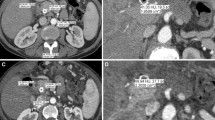Abstract
Objectives
Optimal vascular and parenchymal enhancement for multi-region paediatric body computed tomography (CT) has many challenges. A variety of approaches are currently employed, associated with varying image quality and radiation dose implications. We present a dual bolus intravenous (DBI) contrast technique for single-acquisition imaging of the chest, abdomen and pelvis, with evaluation of multi-compartmental vascular enhancement.
Methods
A DBI regime was designed for use with a programmable dual head pump injector. A larger initial bolus (two-thirds volume) is followed by a smaller bolus (one-third volume) before imaging the chest, abdomen and pelvis in a single acquisition, 45–65 seconds from the start of initial injection. Flow rates and second bolus timing were tailored to patient weight and contrast volume, using five weight categories. Multi-compartmental vascular opacification was graded and image quality was assessed in a cohort of 130 patients.
Results
The DBI technique resulted in concordant multi-compartmental (thoracic aortic, pulmonary arterial, abdominal aortic and portal venous) vascular enhancement. Early splenic parenchymal enhancement artefacts and alterations to renal enhancement were observed.
Conclusion
We present a weight-stratified dual bolus intravenous contrast technique to improve image quality in paediatric multi-region body CT.
Key Points
• In children, optimal vascular and parenchymal enhancement in multi-region CT is challenging.
• A dual bolus contrast technique offers concordant arterial and portal venous opacification.
• Adaptation to patient size is achieved by stratification into five weight categories.
• Dose penalties of ‘overlap’ and ‘dual phase’ imaging techniques can be avoided.





Similar content being viewed by others
Abbreviations
- MDCT:
-
Multi-detector Computed Tomography
- DBI:
-
Dual Bolus Intravenous
- CAP:
-
Chest/Abdomen/Pelvis CT
- NCAP:
-
Neck/Chest/Abdomen/Pelvis CT
References
Brenner DJ, Hall EJ (2007) Computed tomography – an increasing source of radiation exposure. N Engl J Med 357:2277–2284
Slovis TL (2011) Where we were, what has changed, what needs doing: a decade of progress. Pediatr Radiol 41:S456–S460
Nievelstein RAJ, Van Dam IM, Van de Molen AJ (2010) Multidetector CT in children: current concepts and dose reduction strategies. Pediatr Radiol 40:1324–1344
Vock P (2005) CT dose reduction in children (2005). Eur Radiol 15:2330–2340
Sorantin E, Weissensteiner S, Hasenburger G, Riccabonna M (2013) CT in children – dose protection and general considerations when planning a CT in a child. Eur J Radiol 82:1043–1049
Frush DP (2008) Pediatric abdominal CT angiography. Pediatr Radiol 38:S259–S266
Kurian J, Epelman M, Darge K, Meyers K, Nijs E, Hellinger JC (2013) The role of CT angiography in the evaluation of pediatric renovascular hypertension. Pediatr Radiol 43:490–501
Goo HW (2010) State-of-the-art CT imaging techniques for congenital heart disease. Korean J Radiol 11:4–18
Bae KT (2010) Intravenous contrast medium administration and scan timing at CT: considerations and approaches. Radiology 256:32–61
Brisse HJ, Robilliard M, Savignon A et al (2009) Assessment of organ absorbed doses and estimation of effective doses from paediatric anthropomorphic phantom measurements for multidetector row CT with and without automatic exposure control. Health Phys 97:303–314
Brady SL, Yee BS, Kaufman RA (2012) Characterisation of adaptive statistical iterative reconstruction algorithm for dose reduction in CT: a pediatric oncology perspective. Med Phys 39:5520–5531
Frush DP (2008) MDCT in children: scan techniques and contrast issues. Chapter 26 p.331-352. Ed. Kalra MK, Saini S, Rubin GD. Publisher Springer
Loupatatzis C, Schindera S, Gralla J et al (2008) Whole body computed tomography for multiple traumas using a triphasic injection protocol. Eur Radiol 18:1206–1214
Brook OR, Gourtsoyianni S, Brook AB, Siewert B, Kent T, Raptopoulos V (2013) Split bolus spectral multidetector CT of the pancreas: assessment of radiation dose and tumor conspicuity. Radiology 269:139–148
Sauer B, Flocquet M, Batch T, Blum A, Hubert J (2008) Vascular renal anatomy and the ureteropelvic junction: preoperative multidetector CT scanning with split bolus injection as a predictor of laparoscopic findings. J Endod 22:13–17
Bazeed MF, Fooshang FF, Ahmed MA (2011) Low radiation dose dual phase MDCT with split contrast media dose and time optimization: protocol design for renal donors evaluation. Acta Radiol 52:927–932
Acknowledgments
We thank our team of CT technologists who welcomed change, assisted in feedback during the development of the new IV contrast regime, and enabled its smooth introduction into clinical practice. The scientific guarantor of this publication is KE Thomas. The authors of this manuscript declare no relationships with any companies whose products or services may be related to the subject matter of the article. The authors state that this work has not received any funding. No complex statistical methods were necessary for this paper. Institutional Review Board approval was obtained. Written informed consent was waived by the Institutional Review Board. Methodology: retrospective, cross-sectional study, performed at one institution.
Author information
Authors and Affiliations
Corresponding author
Rights and permissions
About this article
Cite this article
Thomas, K.E., Mann, E.H., Padfield, N. et al. Dual bolus intravenous contrast injection technique for multiregion paediatric body CT. Eur Radiol 25, 1014–1022 (2015). https://doi.org/10.1007/s00330-014-3501-6
Received:
Revised:
Accepted:
Published:
Issue Date:
DOI: https://doi.org/10.1007/s00330-014-3501-6




